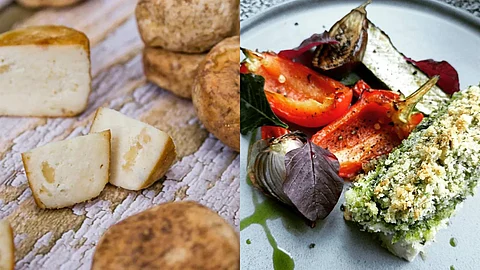
- HOMEGROWN WORLD
- #HGCREATORS
- #HGEXPLORE
- #HGVOICES
- #HGSHOP
- CAREERS
- ABOUT US
- CONTACT US

On 20th May 1498, a Sunday, the Portuguese admiral Vasco da Gama’s fleet arrived in Kappudu near Calicut on the Malabar coast (now Kozhikode in Kerala). The Europeans had finally arrived in India — the age of colonisation had begun. Over the next four and a half centuries, they would shape the course of modern Indian history through brutal conquest and clever politics. Although it’s easy to forget now, the Portuguese were the first to colonise India, and they left a significant impact on the region’s history. Of the many influences they left on Indians, the most enduring one is on food — especially on the way Bengalis make and consume a particular kind of cottage cheese known as Bandel Cheese to this day.
According to food historian K.T. Acharya, orthodox Hindus used to consider split milk a bad omen and would simply throw away curdled milk before the arrival of the Europeans. But this quickly changed after the Portuguese established a colony in Bandel — a town in West Bengal’s Hooghly district approximately 50 kilometres from Kolkata — in 1579. As the Portuguese settlers began making and consuming cheese made from locally available cow’s milk in the town, Bengali cooks employed by the Portuguese and curious Bengali locals slowly picked up some of the Portuguese colonisers’ food habits over the years. Paneer — now a widely-consumed staple of Indian cuisine — is a derivative of the cheese that was first made by 16th-century Portuguese cheese-makers in Bandel.
A salty, smoky, artisanal cheese made from locally available cow’s milk, the Bandel cheese is one of Bengal’s best-kept culinary secrets. Nobody knows how exactly the pungent cheese is made as the few remaining cheese-makers closely guard the secret acidic agent used to curdle fresh milk within their families. To make Bandel cheese, fresh milk is first curdled with this secret acidic agent (most likely a lactic acid extracted from whey), then strained dry, kneaded, and moulded into thick cookie-sized discs. To increase the shelf-life of the cheese, these discs of fresh cheese are then coated with generous amounts of salt, a natural preservative, and cured for at least two days. The cured cheese is then smoked thoroughly over a traditional oven fired by dried cow-dung cakes. While the unsmoked, fresh version is quite creamy and tastes similar to paneer, the smoked version is pungent, dry, and crumbly with a strong terroir, which is ideal for sprinkling on salads or cooking with pasta or risotto.
Today, the production of this unique, elusive cheese has shifted from Bandel, Hooghly, to Bishnupur, Bankura — over a hundred kilometres from its place of origin. Fallout from the Covid pandemic and a lack of awareness and demand has affected the production of Bandel cheese significantly, and most cheese-makers have moved on to other work over the years. Currently, J. Johnson and Mallick & Sons in the 200-year-old labyrinthine New Market in the heart of Kolkata, and The Whole Hog Deli & Charcuterie in Sovabazar are the only shops that still sell Bandel cheese in the city.
It's not all bad news though. In recent years, the West Bengal state government, the Jadavpur University, and the Delhi School of Economics are all trying to secure the coveted GI tag for Bandel cheese and trying to preserve and promote this unique Indian cheese with a colonial era Portuguese connection.
Buy Bandel Cheese from The Whole Hog Deli & Charcuterie here.
